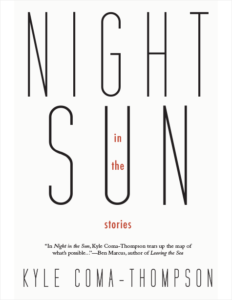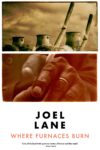Night in the Sun, the second short story collection by Kentucky writer Kyle Coma-Thompson, hints at its binary from the outset. This binary motivates the book’s construction, with the whole split in two equal parts, and it will be there under the skin of each short story, which pulls in the competing directions of sociological analysis and formal play. But it is already on the cover page, in the dark and the light of the book’s evocative title. Because the duality is so imposing, it demands that its two sides be cupped in the palms for closer examination.
A handful of stories into part one of the collection, Coma-Thompson’s two preoccupations coalesce. Firstly, underpinning each of these first stories is a curiosity in the formal potential of the short story. “Idaho,” in which a witness to the massacre of Senegalese street vendors describes this event to a friend, is a story about a story. “New Delta Future” is a story about a town that takes on the history and characteristics of a person. “Seven for a Leper” is a polyphonic story about a man who is so fearful of himself he develops an imagined disease that eats away at his body as if it were a real one. This layered telling is both an imitation of the oral tradition and an exploration of the potential of the written form, a commitment which will be demonstrated throughout the remainder of the collection.
Secondly, Coma-Thompson is preoccupied with privilege in America. Or, more precisely, the what one does as a result of lacking privilege. Many of these stories are about people who, without the vocabulary, maybe even the imagination, are unable to invest in something larger than themselves. The stories use as their backdrop middle America’s current crisis of faith. That which was promised has failed to come. Worse, that which is deserved — the tidings of a lifetime of back-breaking labor, sacrifice, and conformity — seems further away than ever before. “Fortune frowns upon the many; no wonder they reach up to hang upon its bottom lip,” Coma-Thompson writes in “Back Pay (& Other Vagaries).”
These stories depict the fear of others, but also the fear of ourselves. Even “Europe Redux,” a story told from a time-travel enabled future, can be seen to fit with the collection’s theme. It tells the story of the most popular “Interactive Biography,” a program that allows time travelers to go back in time and be somebody, with the most popular biographies being those of soldiers and civilians in World War II Europe. The extreme nostalgia for a perceived glorious past by fictional future time-travelers is analogous to people of today who yearn for a bygone era of perceived greatness, marking the present not as a time of hope but of a futile search for greatness lost. This nostalgia is for an imagined period that seems genuine and rich because of the retrospective compression of history, one that would have the Industrial Revolution over and done with in a couple of busy years.
“The Beast” is about a comedian who has found fame by drawing the crowd into his self-xenophobia and universal prejudice. From a poor background, raised by a single mother, the Beast has literally quipped his way to fame: “One who elevated his admirers by insulting them.” But the comedian’s act is just that, armour worn for protection against a harsh world that has rusted into place. “I had a soft spot for un-tortured good natured failures,” the narrator of “Collectors” says, but this could just as easily be the author speaking.
One of the collection’s true high points is “New Free Europe,” about a US soldier in Berlin. More specifically, it is about a black soldier sent by a white president to a Berlin which, despite being in two pieces, is in the throes of celebration. Again, the complexity of man is explored – the revelling Berliners welcome the soldier and seduce him into joining their partying: “The people were idiots for a day, and though he didn’t follow the full import of their nonsense, he met them with noises and stomping.” Freed from his duties, but especially from his history and skin, the soldier wants nothing more than to hold onto this joy.
Coma-Thompson, it is clear, writes with a sense of history. The great artists of the Industrial Revolution captured the immense historic change taking place around them. The stories here look not at a time of great historic change, but at a time of great historic having-changed. He writes with a sensitivity to the idea that this is already Trump’s America. The guns, the fear, the despair, the faith in barefaced lies – a US on the brink of totalitarianism didn’t arrive at this point overnight, nor is it possible to retreat from it at that pace.
Counter to this, or maybe in conjunction, is Coma-Thompson’s determination to pull at the fabric of the short story; he plays with form like a naughty child, testing its tension as if checking for breaking points. So irresistible to him is it that it takes on the appearance of an impulse.
Like “Idaho,” the story that opens the collection, “A Man (Untitled)” is a story within a story: a poor soul, down on his luck, not seen for years, reappears in town. He is a Fitzgeraldian character — nobody would have noticed his return, or, indeed, his absence, if he wasn’t a mysterious, beautiful idiot. The story skips over the protagonist and settles its narrative focus instead on this old acquaintance, a technique acknowledged more or less explicitly in “The Beast”; the Beast inadvertently forces a cutting of ties between the narrator and his partner, Yvonne. “And what was she like, you might ask,” the narrator says; a paragraph later, the story has concluded. It’s over – if it were important, wouldn’t we know what Yvonne was like by now?
“M.W.” looks at the nature of storytelling from a different angle. A man shoots his sick wife in the night. “Questions, and sure, questions can be answered. But the answers differ depending on who’s asked, and the people usually speak to what’s lost.” This story is a story about the nature of story, the things we hear from others then repeat to ourselves and each other, the way our curiosity settles on one detail over another, and which we later sit at our desks to write down.
Part two opens with “Odin’s Daughter,” a gritty yet lushly composed tale of a gunslinger in a post-apocalyptic Iceland. This is Coma-Thompson at play — the main project of the collection has been abandoned here for a richness and playfulness of prose style and a hero who breathes from the bullet holes riddling his body.
Coma-Thompson’s greatest test of the short story form comes in “Spite & Malice.” This is a tapestry of disparate subjects pulled together to create a whole. Kieślowski, Reagan, Stalin, Descartes, worms, words in translation, Mongols, the card game Spite & Malice – its subjects are collected together, their loose connections working like cartilage to form the skeleton of a narrative.
Like the most exciting stories, “Spite & Malice” succeeds in demonstrating there are no rules and anybody who tells you otherwise is a liar who probably wants your money. This story is the biggest firework on the barge. The biggest and the strangest and the one that does the opposite of everything expected of it:
“Small rooms or dwellings discipline the mind, large ones weaken it,” wrote DaVinci in a handbook on the art of painting. An unfertilized human egg, though tiny, is still observable without aid of microscopes. A single sperm, however, or fleet of them, are not, whether traveling or not disguised as semen. At the monastery in Simonos Petras, monks’ bones are washed in red wine before being placed together in an ossuary. A stack of skulls as tall as a very short man.
It comes late in the collection; why not end with it? “Spite & Malice” takes a compelling, idiosyncratic form. If placed at the collections end, it is not only the collection’s biggest firework, but also its last. It ends on a memorable note of potential, and a story defiantly removed from the collection’s primary sociological thread closes the book out. The couple of stories that follow necessarily erode that potential as they pick up the themes of earlier stories for re-examination.
If any of this speculation comes close to the truth, then the question is clear: is the book’s binary arbitrary? Coma-Thompson never approaches his task lightly, but if grounding his narrative in the sociological is his serious side, formal experimentation is his playful one. They are critical counterpoints to his creative process, an ecosystem in balance — his light and his dark. This is demonstrated most clearly in “M.W.”: by turning a story about a man shooting his wife into a metanarrative about the nature of storytelling, a final judgement of this man is avoided. Some of these characters could bend into evil but resist that temptation. “Several Highly Successful Habits of Bad Men” and “The Beast” toy with ideas of hideousness – the Beast is human ugliness personified, and the bad men are trailed by bad things: “Bring a bad man into your house, and his habits do follow.” But these men are each swatted down. Coma-Thompson unmasks, humanizes. The wife killer, then, is another lost sheep he looks upon with an omniscient grace, never judging, because he knows his secrets. It is a way of further demonstrating that a crisis of faith is less about belief than it is about the believer. Faith, anyway, is a slippery and vague concept. A crisis of faith is actually a crisis of identity. In the same way, old methods of storytelling have merit, but in the face of crisis, a fresh approach is needed. Truth must be trifled up in a new way. This unique collection is both Coma-Thompson’s private revolution, and his harvest from his small plot of land in contemporary America.
Kyle Coma-Thompson is a storyteller, one who can shed his own skin, his own identity, and open his imagination, and heart, to the possibilities of people, and their stories. The role of the storyteller is a basic one. He is not the hero, he is servant to the hero. Many of the heroes of Coma-Thompson’s stories are to be pitied. Sympathized with. Nodded at knowingly because the reader has been there too. They are flawed yet that is not all. Complicated, but for good reason. Outlaws, but only just. If anything, they are treated too kindly. It’s 2016 and Donald Trump is a 50-50 chance of becoming the Leader of the Free World by hands that look just like theirs. At best, Trump’s supporters fail to recognize evil, at worst, they cheer it on. In both extremes, hatred is condoned. And this is the contradiction and difficulty of the humanist principal: have mercy on those who would see you suffer for the same crimes – love thy neighbor by telling their stories too.
I wrote earlier about humanity’s lack of imagination. This is a generalization that, when leveled at a group or populace or species, is, though symptomatic of a web of systemic pressures and policies and influences, arguably fair. It’s a lack of imagination, for instance, that prevents one man from seeing another man from a neighboring country as being just like him. But leveled at an individual, the accusation becomes cruel. Art doesn’t keep the electricity on. Literature doesn’t keep homes unbroken. Poetry doesn’t keep bad news at bay. This is the sensitivity that Coma-Thompson brings to his stories. In “Story for Fire,” Coma-Thompson even offers an easy solution to any lacking imagination: “All one needs to do is forget. Not partially so, but truly, wholly.” These characters are all, in one way or another, and in varying degrees, good. It is this recognition of goodness in the complicated putty we are made from that Coma-Thompson finds his poetry.
Tristan Foster is a writer from Sydney, Australia. He has had writing published in SAND, Fanzine, Black Sun Lit, Music & Literature, The Scofield, Words Without Borders and elsewhere. He is an editor at 3:AM Magazine.
This post may contain affiliate links.








